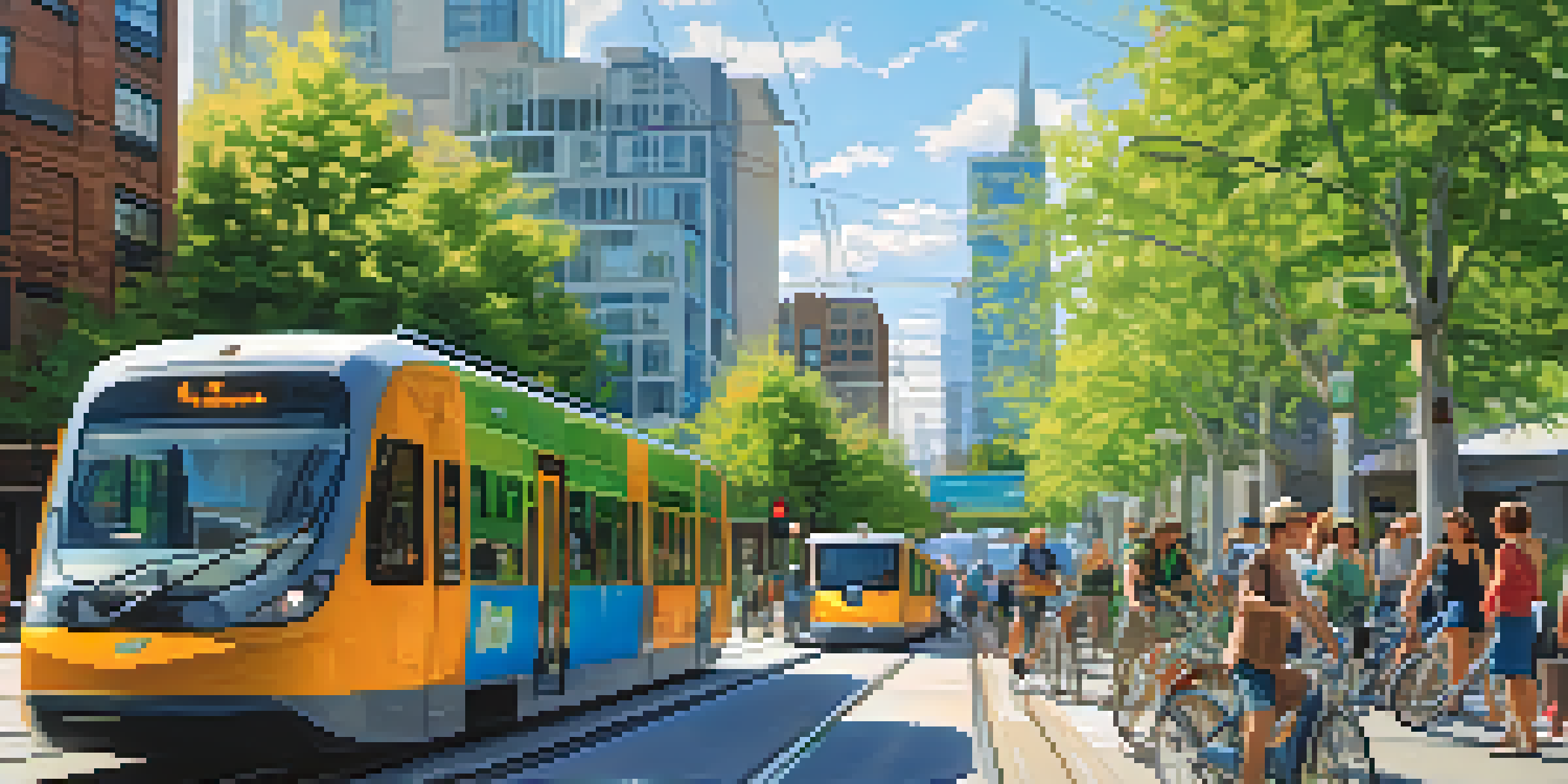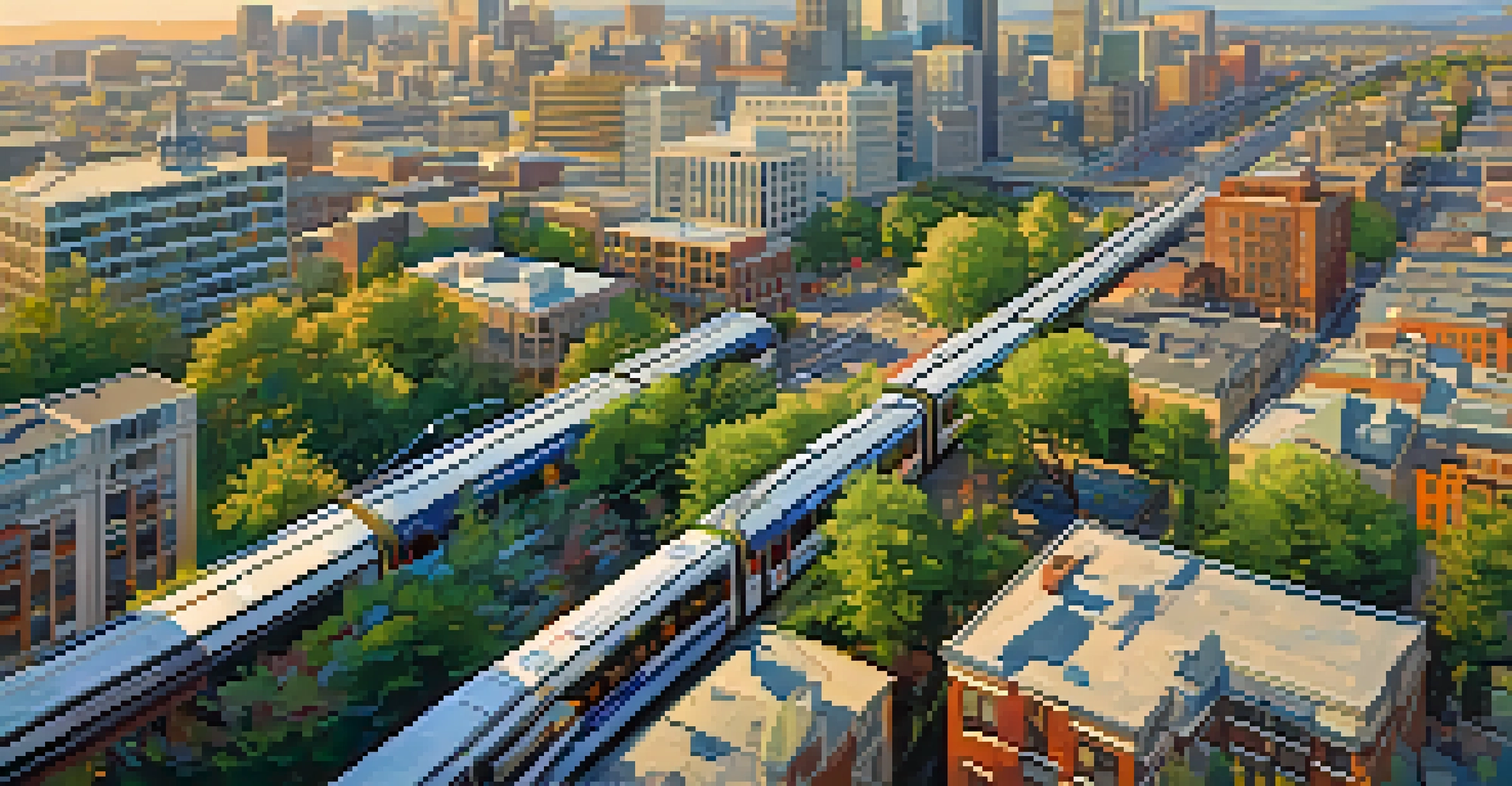How Seattle Promotes Sustainable Transportation Options for All

The Vision: A Sustainable Transportation Future
Seattle has set ambitious goals for a sustainable transportation system that prioritizes accessibility and environmental responsibility. The city's vision focuses on reducing carbon emissions while ensuring that every resident has access to viable transportation options. By integrating public transit, biking, and walking, Seattle aims to create a cohesive network that caters to diverse needs.
Sustainable transportation is not just about reducing emissions; it's about creating a livable city where everyone can thrive.
This vision is not just a lofty ideal; it’s backed by actionable plans and community involvement. Local government collaborates with residents to gather input and shape policies that reflect the community's desires and needs. This participatory approach ensures that everyone feels represented in the decision-making process, fostering a sense of ownership among citizens.
Ultimately, Seattle's vision is about creating a livable city where sustainable transportation options are not just available but encouraged. By promoting eco-friendly travel choices, Seattle aims to enhance quality of life, reduce traffic congestion, and protect the environment for future generations.
Investing in Public Transit Infrastructure
Investments in public transit are vital to Seattle's sustainable transportation strategy. The city has expanded its light rail system, making it easier for residents to commute without relying on personal vehicles. By increasing the reach and frequency of public transit, Seattle is ensuring that more people can choose this eco-friendly option.

In addition to light rail, Seattle is improving bus services, implementing rapid transit corridors, and enhancing accessibility for individuals with disabilities. These improvements not only make public transit more efficient but also encourage more residents to leave their cars at home. The more accessible and reliable the public transit system, the more likely people are to utilize it.
Seattle's Vision for Sustainable Transit
Seattle aims to create a transportation system that prioritizes accessibility, environmental responsibility, and community involvement.
Moreover, Seattle is committed to integrating technology into its public transit system. Real-time tracking apps, for instance, help commuters plan their journeys more effectively. This modern approach to transit helps demystify public transportation and makes it a more appealing option for everyone.
Encouraging Biking and Walking as Alternatives
Seattle recognizes that biking and walking are essential components of a sustainable transportation ecosystem. The city has invested significantly in bike lanes and pedestrian paths, making these modes of transportation safer and more attractive. By creating dedicated lanes and improving infrastructure, Seattle aims to promote biking and walking as viable alternatives to driving.
The best way to predict the future is to create it.
Community programs also play a crucial role in encouraging these sustainable options. Initiatives like 'Bike to Work Month' and 'Walk Seattle' raise awareness about the benefits of non-motorized transport. These programs not only promote healthier lifestyles but also foster a sense of community as residents come together to share their experiences and tips.
Furthermore, Seattle is working to ensure that bike-sharing programs are accessible to all. By providing affordable rental options and strategically placing bike stations throughout the city, Seattle makes it easy for residents and visitors alike to choose biking over driving. This holistic approach contributes to a greener, more connected city.
Promoting Electric Vehicles in the City
As part of its sustainability efforts, Seattle is actively promoting electric vehicles (EVs) to reduce greenhouse gas emissions. The city has established numerous charging stations to support the growing number of electric cars on the road. This infrastructure investment encourages residents to consider EVs as a practical alternative to conventional vehicles.
In addition to expanding charging availability, Seattle offers incentives for residents who purchase electric vehicles. These incentives can include tax breaks, rebates, and access to carpool lanes, making the switch to electric more appealing. By lowering the barriers to entry, the city is fostering a transition toward cleaner transportation options.
Investment in Public Transit Growth
The city is expanding its public transit infrastructure, including light rail and bus services, to promote eco-friendly commuting options.
Moreover, Seattle's commitment to sustainability extends beyond personal vehicles. The city is also exploring electric public transit options, including electric buses. This forward-thinking approach not only reduces emissions but showcases Seattle as a leader in embracing innovative transportation technologies.
Community Engagement in Sustainable Transportation Planning
Community engagement is at the heart of Seattle's sustainable transportation initiatives. The city regularly hosts workshops, forums, and surveys to gather feedback from residents about their transportation needs and preferences. This input is invaluable in shaping policies that reflect the actual needs of the community.
By actively involving citizens in the planning process, Seattle ensures that transportation solutions are tailored to fit the diverse demographics of the city. Whether it’s addressing concerns about accessibility for seniors or creating bike paths for families, community voices help guide decisions. This approach not only enhances public trust but also fosters a sense of collective responsibility.
Furthermore, partnerships with local organizations amplify these efforts. Collaborations with non-profits, schools, and businesses help spread awareness and garner support for sustainable transportation initiatives. Together, they work to create a culture that values and prioritizes eco-friendly travel options.
Addressing Equity in Transportation Access
Seattle is committed to ensuring that sustainable transportation options are accessible to all, particularly underserved communities. This focus on equity is crucial, as not everyone has equal access to public transit, biking, or walking paths. By identifying and addressing these disparities, Seattle aims to create a more inclusive transportation system.
The city has launched initiatives aimed at improving accessibility in marginalized neighborhoods. This includes expanding public transit routes, increasing service frequency, and investing in safe walking and biking infrastructure. By removing barriers and enhancing access, Seattle is working to ensure that everyone can participate in the shift toward sustainable transportation.
Equity in Transportation Access
Seattle is dedicated to ensuring that sustainable transportation options are accessible to all residents, particularly underserved communities.
Additionally, community outreach programs educate residents about available transportation options, including subsidies for low-income individuals. By promoting these resources, Seattle empowers all its citizens to make sustainable choices, regardless of their economic situation. This commitment to equity enriches the fabric of the city and strengthens community bonds.
The Future of Sustainable Transportation in Seattle
Looking ahead, Seattle's commitment to sustainable transportation continues to evolve. The city is exploring innovative technologies, such as autonomous vehicles and smart traffic management systems, to enhance its transportation network. These advancements could significantly improve efficiency and reduce emissions, further aligning with Seattle's sustainability goals.
Moreover, as climate change becomes an increasingly pressing issue, Seattle is poised to adapt its strategies accordingly. The city is actively researching and implementing practices that can mitigate the environmental impacts of transportation. This proactive approach ensures that Seattle remains at the forefront of sustainable transportation practices.

Ultimately, Seattle's journey toward a sustainable transportation future is a collaborative effort. By bringing together government, businesses, and community members, the city is paving the way for a greener, more connected urban environment. The future looks bright for sustainable transportation in Seattle, and everyone has a role to play in this exciting transformation.